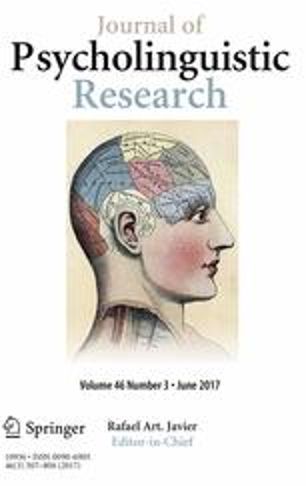【限时资源,期刊全文】Journal of Psycholinguistic Research(《心理语言学研究杂志》)2019年全6期论文集(侵删)
1403 阅读 16 下载 2020-06-24 18:13:59 上传 9.38 MB
本期推送的是SSCI期刊Journal of Psycholinguistic Research(《心理语言学研究杂志》)2019年全6期(即第48卷1-6期共76篇论文),其中目录可以在正文中查看,全文可以于即日起3天内点击文末附件列表下
Journal of Psycholinguistic Research《心理语言学研究杂志》2019年全6期76篇论文(侵删)
资源整理:张明辉(微信:zhangxiaojian160408)
(资源限时三天下载,三天后即失效,若仍想获取,请加小编微信)

| 卷号 | 期号 | 论文号 | 论文题目 |
| Vol. 48 | Issue 1 | Artcile 01 | The Roles of Relative Linguistic Proficiency and Modality Switching in Language Switch Cost: Evidence from Chinese Visual Unimodal and Bimodal Bilinguals |
| Vol. 48 | Issue 1 | Artcile 02 | Understanding Prosodic Focus Marking in Mandarin Chinese: Data from Children and Adults |
| Vol. 48 | Issue 1 | Artcile 03 | The Similarities Between the Target and the Intruder in Naturally Occurring Person Naming Errors: A Comparison Between Repeated and Single Naming Confusions |
| Vol. 48 | Issue 1 | Artcile 04 | Factors Influencing L2 Self-repair Behavior: The Role of L2 Proficiency, Attentional Control and L1 Self-repair Behavior |
| Vol. 48 | Issue 1 | Artcile 05 | The Meeting Point: Where Language Production and Working Memory Share Resources |
| Vol. 48 | Issue 1 | Artcile 06 | A Developmental Perspective on Processing Semantic Context: Preliminary Evidence from Sentential Auditory Word Repetition in School-Aged Children |
| Vol. 48 | Issue 1 | Artcile 07 | Power Talk: Communication Styles, Vocalization Rates and Dominance |
| Vol. 48 | Issue 1 | Artcile 08 | Joint Contributions of Multilevel Linguistic Knowledge to Character Meaning Retention in L2 Chinese |
| Vol. 48 | Issue 1 | Artcile 09 | L1 Orthography in L2 Chinese Morphological Awareness: An Investigation of Alphabetic and Abugida Readers |
| Vol. 48 | Issue 1 | Artcile 10 | Use of Prosocial Word Enhances the Processing of Language: Frequency Domain Analysis of Human EEG |
| Vol. 48 | Issue 1 | Artcile 11 | Blue is in the Eye of the Beholder: A Cross-Linguistic Study on Color Perception and Memory |
| Vol. 48 | Issue 1 | Artcile 12 | The Processing of Grammatical Gender Agreement in Brazilian Portuguese: ERP Evidence in Favor of a Single Route |
| Vol. 48 | Issue 1 | Artcile 13 | What Can We Learn About Psychopathic Offenders by Studying Their Communication? A Review of the Literature |
| Vol. 48 | Issue 1 | Artcile 14 | The Influence of Presentation Format of Story on Narrative Production in Chinese Children Learning English-as-a-Second-Language: A Comparison Between Graphic Novel, Illustration Book and Text |
| Vol. 48 | Issue 1 | Artcile 15 | Core Semantic Links or Lexical Associations: Assessing the Nature of Responses in Word Association Tasks |
| Vol. 48 | Issue 2 | Artcile 16 | The Potential Relationship Between Openness and Explicit Versus Implicit L2 Knowledge |
| Vol. 48 | Issue 2 | Artcile 17 | Acquisition of Stop Consonants in Mandarin-Japanese Early Bilingual Children |
| Vol. 48 | Issue 2 | Artcile 18 | Correction to: Acquisition of Stop Consonants in Mandarin-Japanese Early Bilingual Children |
| Vol. 48 | Issue 2 | Artcile 19 | Towards Conceptualizing Language Learning Curiosity in SLA: An Empirical Study |
| Vol. 48 | Issue 2 | Artcile 20 | The Role of Working Memory, Language Proficiency, and Learners’ Age in Second Language English Learners’ Processing and Comprehension of Anaphoric Sentences |
| Vol. 48 | Issue 2 | Artcile 21 | Role of Resilience in (De)Motivation and Second Language Proficiency: Cases of Korean Elementary School Students |
| Vol. 48 | Issue 2 | Artcile 22 | Native Korean-Speaking Children Learning to Read in English: A Structural Analysis of L2-English Literacy Acquisition |
| Vol. 48 | Issue 2 | Artcile 23 | On the Relation Between Procedural Learning and Syntactic Proficiency in Gifted Children |
| Vol. 48 | Issue 2 | Artcile 24 | Predictive Language Processing in Preschool Children with Autism Spectrum Disorder: An Eye-Tracking Study |
| Vol. 48 | Issue 2 | Artcile 25 | Delayed Application of Binding Condition C During Cataphoric Pronoun Resolution |
| Vol. 48 | Issue 2 | Artcile 26 | A Developmental Study of the Narrative Components and Patterns of Chinese Children Aged 3–6 Years |
| Vol. 48 | Issue 2 | Artcile 27 | Homophone Advantage in Sentence Acceptability Judgment: An Experiment with Japanese Kanji Words and Articulatory Suppression Technique |
| Vol. 48 | Issue 2 | Artcile 28 | Is There an Orthographic Boost for Ambiguous Words During Their Processing? |
| Vol. 48 | Issue 2 | Artcile 29 | The Book Dog and Semiotic Resources in Envisionment Building of a Text World |
| Vol. 48 | Issue 3 | Artcile 30 | Anaphoric Reference to Quantified Expressions in Swedish |
| Vol. 48 | Issue 3 | Artcile 31 | Acquisition of Reading and Intellectual Development Disorder |
| Vol. 48 | Issue 3 | Artcile 32 | Levels of Abstractness in Semantic Noun and Verb Processing: The Role of Sensory-Perceptual and Sensory-Motor Information |
| Vol. 48 | Issue 3 | Artcile 33 | Narrative Competence of Adult L2 Russian Learners |
| Vol. 48 | Issue 3 | Artcile 34 | The Power of an Image: Images, Not Glosses, Enhance Learning of Concrete L2 Words in Beginning Learners |
| Vol. 48 | Issue 3 | Artcile 35 | Rapid Serial Visual Presentation Interacts with Ambiguity During Sentence Comprehension |
| Vol. 48 | Issue 3 | Artcile 36 | Latent Semantic Analysis Discriminates Children with Developmental Language Disorder (DLD) from Children with Typical Language Development |
| Vol. 48 | Issue 3 | Artcile 37 | The Role of Short Vowels in Arabic Listening Comprehension |
| Vol. 48 | Issue 3 | Artcile 38 | Embodiment Effect on the Comprehension of Mandarin Manual Action Language: An ERP Study |
| Vol. 48 | Issue 3 | Artcile 39 | Input Training Matters in L2 Syntactic Representation Entrenchment: Evidence from a Follow-Up ERP Study |
| Vol. 48 | Issue 3 | Artcile 40 | Sensitivity to Inflectional Morphemes in the Absence of Meaning: Evidence from a Novel Task |
| Vol. 48 | Issue 4 | Artcile 41 | Academic Vocabulary Knowledge and Reading Comprehension Skills Among Seventh-Graders in Arabic as L1 |
| Vol. 48 | Issue 4 | Artcile 42 | The Role of Short Vowels in Reading Arabic: A Critical Literature Review |
| Vol. 48 | Issue 4 | Artcile 43 | The Development of Anaphora Resolution in Spanish |
| Vol. 48 | Issue 4 | Artcile 44 | On the Implicit Anaphoric Argument of Relational Nouns in Mandarin Chinese |
| Vol. 48 | Issue 4 | Artcile 45 | Grammar, Gender and Demonstratives in Lateralized Imagery for Sentences |
| Vol. 48 | Issue 4 | Artcile 46 | The Voice and Speech Quality Correlates of Psychological Observations in Jungian Active Imagination Experiment |
| Vol. 48 | Issue 4 | Artcile 47 | A Note on the Voice Mismatch Asymmetry in Ellipsis |
| Vol. 48 | Issue 4 | Artcile 48 | The Effects of Vocabulary Enhancement Exercises and Group Dynamic Assessment on Word Learning Through Lexical Inferencing |
| Vol. 48 | Issue 4 | Artcile 49 | Willingness to Communicate: A Predictor of Pushing Vocabulary Knowledge from Receptive to Productive |
| Vol. 48 | Issue 4 | Artcile 50 | Subject–Aux Inversion in Children with SLI |
| Vol. 48 | Issue 5 | Artcile 51 | Language Learnability Analysis of Hindi: A Comparison with Ideal and Constrained Learning Approaches |
| Vol. 48 | Issue 5 | Artcile 52 | How Do Different Types of Alignment Affect Perceived Entity Status? |
| Vol. 48 | Issue 5 | Artcile 53 | Causal Information Over Facial Expression: Modulation of Facial Expression Processing by Congruency and Causal Factor of the Linguistic Cues in 5-Year-Old Japanese Children |
| Vol. 48 | Issue 5 | Artcile 54 | The Use of a Reading Lexicon to Aid Contextual Vocabulary Acquisition by EFL Arab Learners |
| Vol. 48 | Issue 5 | Artcile 55 | Investigating the Declarative-Procedural Gap for the Indirect Speech Construction in L2 Learners |
| Vol. 48 | Issue 5 | Artcile 56 | The Impact of the Position of Phonemes and Lexical Status on Phonological Awareness in the Diglossic Arabic Language |
| Vol. 48 | Issue 5 | Artcile 57 | How do Emotion Word Type and Valence Influence Language Processing? The Case of Arabic–English Bilinguals |
| Vol. 48 | Issue 5 | Artcile 58 | The Semantic Integration Between Two Subliminally Perceived Words Simultaneously Presented at Different Locations |
| Vol. 48 | Issue 5 | Artcile 59 | The Aachen List of Trait Words |
| Vol. 48 | Issue 5 | Artcile 60 | Processing of Translation-Ambiguous Words by Chinese–English Bilinguals in Sentence Context |
| Vol. 48 | Issue 5 | Artcile 61 | Strategy Use in Oral Communication with Competent Synthesis and Complex Interaction |
| Vol. 48 | Issue 5 | Artcile 62 | Factors Related to Linguistic Content in Video Narrative of Adolescents with Cancer and Healthy Controls |
| Vol. 48 | Issue 5 | Artcile 63 | Conflict Processing is Modulated by Positive Emotion Word Type in Second Language: An ERP Study |
| Vol. 48 | Issue 5 | Artcile 64 | Children’s Comprehension of Irony: Studies on Polish-Speaking Preschoolers |
| Vol. 48 | Issue 6 | Artcile 65 | A Meta-analysis of L2 Willingness to Communicate and Its Three High-Evidence Correlates |
| Vol. 48 | Issue 6 | Artcile 66 | The Effects of Meaning Dominance in the Time-Course of Activation of L2 Lexical Ambiguity Processing |
| Vol. 48 | Issue 6 | Artcile 67 | Speedy Metonymy, Tricky Metaphor, Irrelevant Compositionality: How Nonliteralness Affects Idioms in Reading and Rating |
| Vol. 48 | Issue 6 | Artcile 68 | Impact of Learning a Foreign Language on the Enhancement of Cognitive Functions Among Healthy Older Population |
| Vol. 48 | Issue 6 | Artcile 69 | Are French Fries a Vegetable? Lexical Typicality Judgement Differences in Deaf and Hearing Learners |
| Vol. 48 | Issue 6 | Artcile 70 | The Structure of the Concepts Related to Love Spectrum: Emotional Verbal Fluency Technique Application, Initial Psychometrics, and Its Validation |
| Vol. 48 | Issue 6 | Artcile 71 | Uneven Linguistic Outcome in Extremely Preterm Children |
| Vol. 48 | Issue 6 | Artcile 72 | The Affective Meaning of Words is Constrained by the Conceptual Meaning |
| Vol. 48 | Issue 6 | Artcile 73 | The Influence of Orthography on Phonemic Knowledge: An Experimental Investigation on German and Persian |
| Vol. 48 | Issue 6 | Artcile 74 | Morphological De-com-pos-it-ion Helps Recognize Low-er Frequency Words in Typically Developing Spanish-Speaking Children |
| Vol. 48 | Issue 6 | Artcile 75 | Verbal Descriptions Accompanying Numeric Information About the Risk: The Valence of Message and Linguistic Polarity |
| Vol. 48 | Issue 6 | Artcile 76 | Performance Differences in Hindi and English Speaking Bilinguals on Stroop Task |
所需积分:0 分
限期开放已结束
相关工具
表情
图片
附件
















